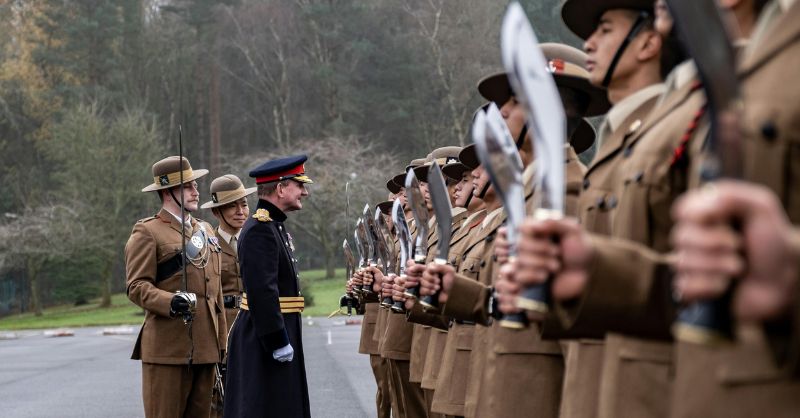
Representational image
The Gorkhas are a group of people originating from the rugged mountainous regions of Nepal. Renowned for their valor, discipline, and fierce loyalty, Gorkhas have a legendary reputation as some of the finest soldiers in the world. Their battle cry, “Ayo Gorkhali” (“The Gorkhas are coming”), is enough to strike fear into the hearts of their adversaries.
Their martial tradition dates back centuries, with their skills in warfare becoming internationally recognized after their fierce resistance against the British East India Company during the Anglo-Nepalese War (1814-1816). The British were so impressed by the Gorkhas’ combat prowess that they decided to recruit them into their own military forces, thus laying the groundwork for the formation of the Gorkha regiments.
A few days back, we also wrote about what happens to your body and mind before you die in an accident. It’s an interesting read for you as well.
Demography and profile of Gorkhas
Gorkhas primarily hail from the hilly and mountainous regions of Nepal, including districts such as Gorkha, Lamjung, and Kaski. The population comprises diverse ethnic groups, including Gurungs, Magars, Rais, and Limbus, each contributing unique cultural and martial traditions.
Physically, Gorkhas are known for their resilience and endurance, which stem from their upbringing in harsh terrains and challenging climates. Their hallmark weapon, the khukri—a curved blade—symbolizes their martial heritage and is both a practical tool and a formidable weapon in battle.
The relationship between Nepal and the British Empire
The formation of the Gorkha regiments can be traced back to the Treaty of Sugauli (1816), which ended the Anglo-Nepalese War. Despite their defeat, the Gorkhas earned the respect of the British, leading to the establishment of Gorkha recruitment centers. By 1815, the British had already begun enlisting Gorkhas into their military.
During the British Raj, the Gorkha regiments became an integral part of the Indian Army, playing crucial roles in major conflicts such as the Indian Rebellion of 1857, the World Wars, and various colonial expeditions.
The Jallianwala Bagh connection: General Dyer’s Gorkhas
One of the darkest chapters in Indian history—the Jallianwala Bagh massacre in 1919—had an indirect connection to the Gorkhas. General Reginald Dyer, responsible for ordering the massacre, had previously commanded Gorkha soldiers. Though Gorkhas were not directly involved in the atrocity, the event highlighted the complexities of serving a colonial power, where loyalty to the chain of command sometimes clashed with ethical considerations.
Field Marshal Sam Manekshaw and the Gorkhas
Field Marshal Sam Manekshaw, one of India’s most celebrated military leaders, held the Gorkhas in the highest regard. He often recounted anecdotes of their bravery during battles, particularly in the Indo-Pak wars. Once, he famously remarked, “If a man says he is not afraid of dying, he is either lying or is a Gorkha.”
What Hitler said about Gorkhas
Even Adolf Hitler, infamous for his ruthlessness, acknowledged the Gorkhas’ unparalleled combat skills. During World War II, he reportedly warned his troops about engaging with Gorkha soldiers, admiring their fearlessness and tenacity.
How many Gorkha Regiments are there?
Currently, the Indian Army boasts seven Gorkha regiments, each with multiple battalions. These regiments have distinct traditions and battle honors but share the same ethos of courage and loyalty. The British Army, too, continues to maintain a brigade of Gorkhas, honoring a tradition that dates back more than two centuries.
Comparing Gorkhas to other defense forces worldwide
The Gorkhas’ discipline, resilience, and combat effectiveness place them among the elite forces of the world. Their regiments are often compared to other legendary military units like the Gurkha Brigade in the British Army, the French Foreign Legion, and the U.S. Navy SEALs. However, their unique blend of humility, loyalty, and ferocity sets them apart, earning admiration across the globe.
On the valor part of the Gorkhas, Field Marshal Sam Manekshaw said, “Brave men may not live forever, but the cautious do not live at all. The Gorkhas are the bravest of the brave.”
Also Sir Ralph Turner (British linguist and officer), also had said similar words: “In the world’s history, there has never been more devoted or valiant soldiers than the Gorkhas.”
Facts and figures about Gorkhas
- Over 200,000 Gorkhas served in the British Army during the World Wars.
- Gorkhas have received numerous gallantry awards, including the Victoria Cross (26 recipients) and Param Vir Chakra.
- The Indian Army’s Gorkha regiments have participated in every major conflict post-independence, including the Kargil War.
How Nepal views the Gorkha Regiments today
Nepal’s perception of the Gorkha regiments has evolved over time. While there is immense pride in the Gorkhas’ valor, recent shifts in Indian military policies, such as the Agnipath scheme, have raised concerns. Nepal fears that reduced tenure and benefits for Gorkha recruits might impact their economic and social stability.
With changing dynamics, there is a growing concern about how external forces like China might exploit any discontent among the Gorkhas. China’s increasing influence in Nepal could potentially strain the historical ties between India and Nepal regarding the Gorkha recruitment system.
What we think about it
The Gorkha Regiment and Rifles are not just a part of the Indian Army; they are its backbone. Their legendary bravery, unwavering loyalty, and unparalleled combat skills make them an indispensable asset.
For over two centuries, Gorkhas have stood as a symbol of valor and dedication, protecting borders and upholding peace. In an era of geopolitical uncertainties, their legacy serves as a reminder of the power of courage, unity, and service to a greater cause. Their story continues to inspire, urging us to honor their contributions and preserve their proud heritage.



